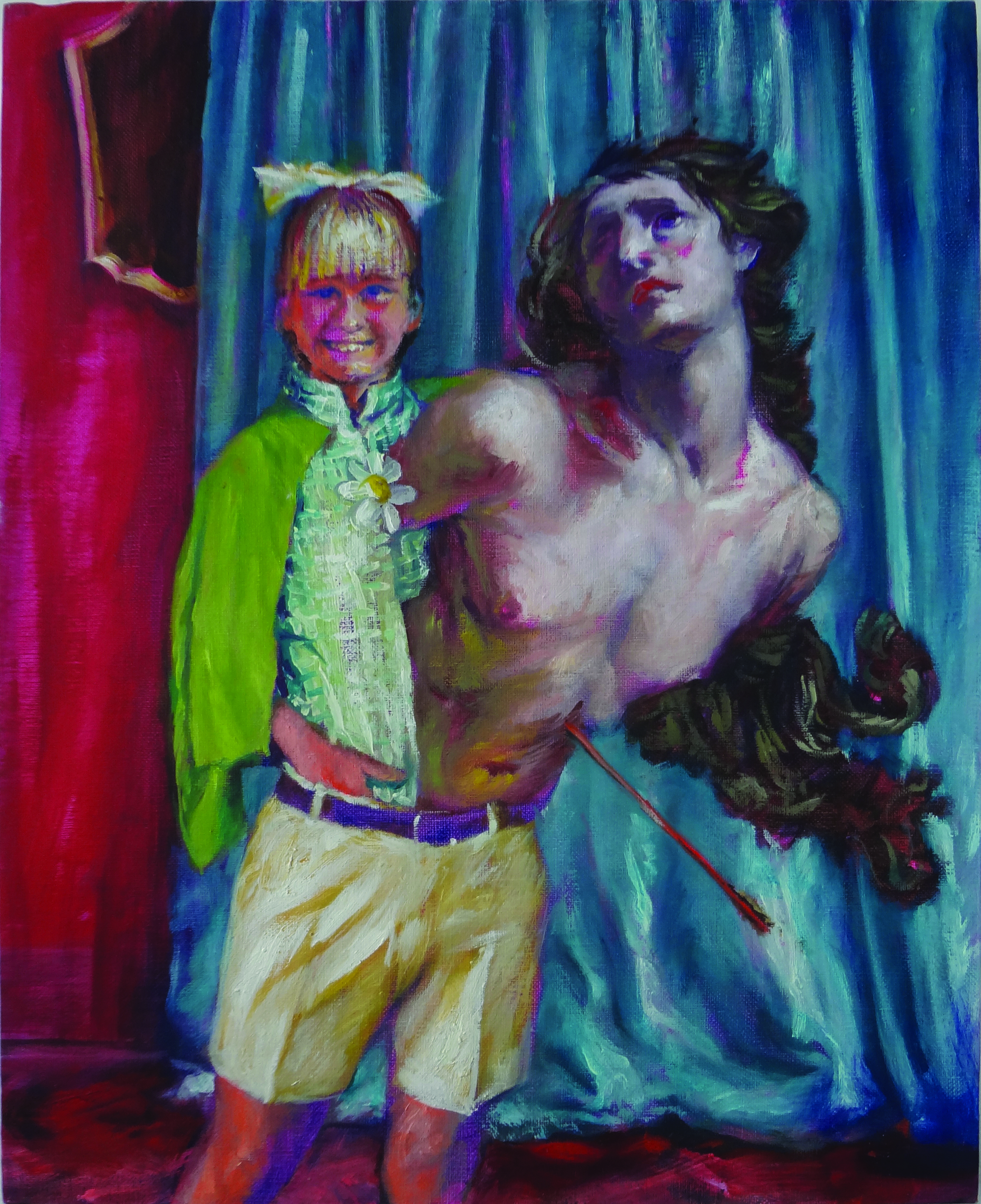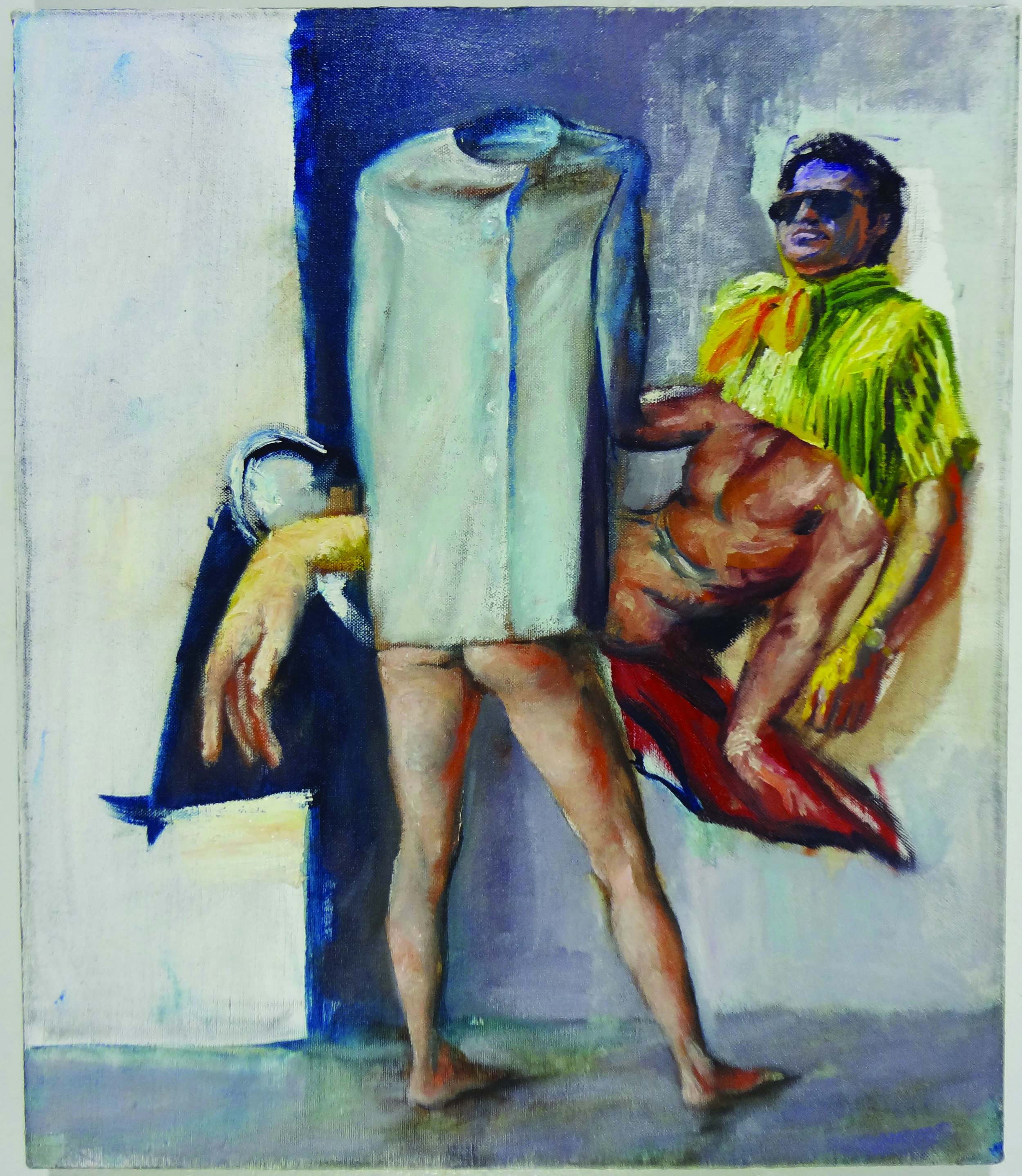“They Are Sebastian”
Catherine Fosnot Gallery, New London CT
2022
They are Sebastian, Don Doe (2018), 20” x 16” oil on linen
Interview:
Catherine Fosnot / Don Doe
In early February of 2022, I made a visit to one of two studios in Brooklyn NY of the painter and sculptor, Don Doe. We spent a few hours in his first studio looking at paintings from his new series. I was so mesmerized and intrigued with this new work that we never made it to his second studio, which houses his sculptures. Instead, we sat down and discussed his new paintings.
Catherine Fosnot: Don, I’m absolutely fascinated with these new paintings. They seem at once to be about the many-faceted nature of personality, the many selves we each can make visible to others if we choose—such powerful images portraying the complexity of identity, and even gender. What a timely topic. Talk to me about this work.
Don Doe: Our views of ourselves can often be so different to the views that others see of us. I’m trying to raise the question: “Who are we really and when are we?”
Catherine: When I look at your images, I see no objective reality in any of them, only juxtapositions of multiple interpretations to cause viewers at once to see the complexity in what we observe and think we know. Your art images depict the complexity of perception, and hence the constructed nature of meaning. I love the title we agreed upon for this show They are Sebastian.
Don: In my current series of works, I’ve vacillated between the titles “Bodies Unbound” and “Simultaneous Egos” which naturally sprouted from my previous series, “Compounded Narratives.” I am trying to give form to a notion of the existence of entwining identities or egos caught in a moment of contradiction; perhaps moving, de-stabilizing, transforming, or shape-shifting the boundaries of the body as if to give form to the person as seen by themselves, but simultaneously as perceived by others. For me, it’s as if growing towards the future self yet in that body is both the past idealized self and future selves in tandem. These images are a way to fight my fears. The images give me pleasure: the mixed bodies trying to untangle; the beauty in the end urges questions of how the body is personal. Ambiguous fractured dispositions of the capricious figure suggest the body’s mutability into an object that can be ingested and chewed and rearranged to suggest a narrative.
Catherine: You mentioned entwined identities caught in a moment of contradiction, past and present. In works, such as Outside the Castle, They are Sebastian, and The Squash Lesson Four-Walled Court, you present us with anachronisms—dualities of chronological inconsistencies, figures misplaced in time outside their proper temporal domain, perhaps to surprise us? Is this purposeful?
Don: I have a desire to create metaphorical shapes that are powerful and disturbing. In this series, They are Sebastian, I like the qualities of unfinishedness and incompleteness that struggle to balance opposites all the while. I wonder, “What would that body look like and in what time?” Some of the figures have a fragmented troubling look to them that perhaps looks a bit ludicrous, but it is never a classical portrait that would not allow a form in transition to exist. Myth and change over time both interest me, so it is hard for me not to use them as motifs. Sometimes that makes the images become beast-like and grotesque. Yet I have succeeded with surrealist ploys to get close to what I like, I think. It is a world I am still building, having just started it 7 years ago. Each piece is a conversation that acts as a reunion between the past and a present as if there is no other way. I might be subverting representational conventions, but I hope in a fresh way, especially with the female nude. It is now important to be questioning the bodies’ boundaries and hyper-exaggerated anti-classical posteriors, arms, asymmetries, or protrusions. Perhaps our sense of the body has outgrown itself as a new ego ‘pupa’ emerges, not unlike some insects or budding flowers. It is as if we witness to conceive a second body. I like how some of my images can mischievously toy with old romantic equations, classical mathematics, and realist skepticism, a pastoral alternative, even memories of my deepest childhood. Why would I care to do this mystifies me, except that it feels right and the thing I should be doing.
Catherine: Where do you get your inspiration? And what is your process like?
Don: I get inspiration from magazines. Those odd snap shots found adrift of their context at flea markets have an appeal, as often they are just of an instant. I like the push and pull between the source of the photo, what I imagine could be going on, and the materials I am using. Juxtaposed, they produce an exploration into what might take place through the potential transformations. The emotional result is sometimes scary. The photos I gravitate towards have a specific “source-and-time” that is evident as soon as you see them. As I combine several photos into one composition, tension between them emerges with the contradicting time periods of the photos affecting the whole. Somewhere in that swamp, the idea of the sculpture emerges. I am reluctant to assign meaning to the works but feel in some way that they are updating ancient myths. My process is often about reusing found imagery that has a forgotten place, that was once found on eBay as grist for me to construct a dense trigger—a trigger from the juxtaposition of periods in history and differing points of view. Then I play with the expectations each photo is assumed to have that we assume is recognizable. There’s no one-to-one correspondence between any kind of inner experience I’m having and what I sculpt or draw, but certainly unresolved thoughts about sexual persona play a role.
Catherine: There is often humor in your work, too. I just love your treatment of the hands and the facial expressions on the figures in Secret Bouquet
Secret Bouquet, Don Doe (2017), 48” x 36” oil on linen
Don: Some of my works start with a naughty formalist joke; images turbulent but often exuberantly naked; perhaps sometimes even with full, pendulous breasted women or male genitalia. But other pieces are emotional and sad. For example, when I was working on Sometimes the Rain Doesn’t Stop, I was thinking about the Beatles’ song Fixing a Hole Where the Rain Gets In.
Sometimes the Rain Doesn't Stop, Don Doe (2017), 30” x 24” oil on linen
Catherine: Who are some of the artists that through the years have inspired you?
Don: Oh, I have a long list. Here’s a start: Hans Bellmer, Hannah Hock, R. B. Kitaj, Francis Picabia, Balthus, Max Ernst, Louise Bourgeois, Nicola Tyson, Augustus Rodin, Daniel Richter, Francis Bacon, Andre Kertesz, and Jean-Baptiste Carpeaux. I could say my work seeks to make visible my inner experience of current topics in society and it serves as a tool or process for me to sort myself out. Various works focus on human images and on the human psychology evoking some political or social context, maybe as a reaction to existing conditions but certainly not expressing any utopian ideals. Moreover, my interest is in the forms our current social environment is suggesting. As I experiment with collage combinations of individual body parts in scale and source to provide several evocative silhouettes around each work, I’m probing the psyches of my constructed subjects. To maintain an interest in our current narcissistic search for identity, I am striving to integrate the series of paintings with an appropriate media for the sculpture. In sculpture the inherent properties of the materials I’m using are very significant to interrelate the subject matter with the most evocative form of the medium I’ve chosen. For the most part the chosen medium in my sculpture work is clay over an expressive armature presented on a found object, such as plinth, wherein the armature often seems to be struggling to separate itself and emerge from the clay to stand alone. With sculpture I like to think I am connecting with the practice of A. Rodin’s impressionistic sculpture and the terracotta studies of Jean-Baptiste Carpeaux. Within the necessary armature the reference might be more like a wound-up spring about to expand. At times it’s like a lease attached to feisty dog, or a laboratory ring-stand apparatus holding aloft a condensing liquid. More often within sculpture, I am drawn towards an emotionally charged handling of the subject to get back an emphatic response from the viewer. This is all to get at unconventional juxtapositions of forms to convey excesses of feeling within the search for identity.
Catherine: And now you are enticing me to make a second visit to see the works in your sculpture studio!



